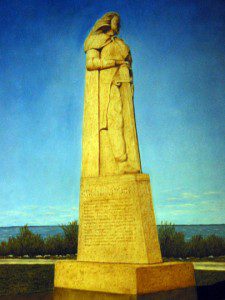LA SALLE
Rene Robert Cavelier, Sieur de la Salle started out on July 24, 1684, his mission, to find the mouth of the Mississippi and possibly expand the holdings of France to the west. On a previous trip down the river, La Salle had claimed the Mississippi and all lands drained by it for his sovereign, Louis XIV. Now he wanted to establish a new colony at the mouth of the river.
With the funding in place, La Salle started to outfit ships for the expedition. Four ships were prepared, the Jolie , a French warship with thirty-six guns; the ketch, the St. Francois carried ammunition, live animals and merchandise for Santo Domingo; the Aimable, his supply ship that carried everything they would need to establish the colony; and the Belle, a barque longue with six guns.
Among the volunteers who joined the expedition in La Rochelle were several families, a few single women, some children, clerics, mechanics, and workmen. La Salle’s brother and two nephews joined him, as well. Also aboard was Henri Joutel who kept a journal of the entire trip. It is due to his diligence that we know so much about what happened on that fateful trip.
The St Francois was captured by Spanish pirates in the Caribbean and an illness took hold of La Salle and his men. Finally he got underway with the remaining three ships and entered the Gulf of Mexico. The maps of the time had the mouth of the Mississippi approximately where La Salle landed. Unfortunately, they were about 400 miles southwest of the river itself. Where he did land is what we know today as Matagorda Bay.
The Belle managed to make it into the bay, as it was a shallow draft ship but the Aimable ran aground. It ran aground and high winds and waves split the ship apart. Most of the cargo was gone, some out to sea and the rest sinking on the spot. They had lost everything that would guarantee a successful settlement: ammunition, tools, blacksmithing supplies, pans, utensils and more. The captain of the Aimable, Beaujeu, left the group with only the Belle when he simply took the Jolie and headed back to France never to return.
Events went from bad to worse. Needing canoes, La Salle sent his men to barter for some at a nearby Indian camp. His men found the Karankawa Indians had recovered a number of blankets from the sunken ship. La Salle sent Ensign du Hamel and a recovery party to barter peacefully for the blankets. Instead, Hamel scared the Indians off and simply stole the blankets back. The Indians considered this an act of war and attacked the party as it was camped for the night on the beach. Two of the men were killed and others wounded.
This brought about the building of a fort. While this was taking place La Salle went off on one of his many expeditions seeking the missing Mississippi river. Eventually it was decided the placement of the fort and settlement were too conspicuous and they were moved further inland along what is now Garcitas creek, the site of which is now a private ranch.
The main source of their food, at this time was bison. Although they had brought seeds to plant, there were far to many wild animals that enjoyed the tasty shoots the plats provided. They planted according the French growing season and the gardens refused to produce.
Morale was low; La Salle was never there when needed. The crushing blow, to the colony was the sinking of the Belle. When La Salle headed off to find the Mississippi, he left those in the fort virtually defenseless. La Salle, himself, was assassinated near what is now Navasota, Texas and most of colonists left behind died from disease or Karankawa attack.
La Salle’s final journey was total folly. Only a handful of the original colonists that started out with him arrived back in France. We know of his trip because of Joutel’s journal and the artifacts that were salvaged from his ship, La Belle.